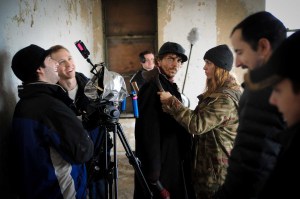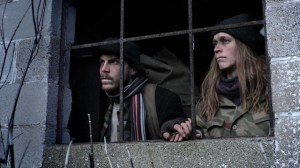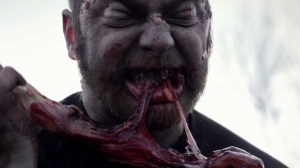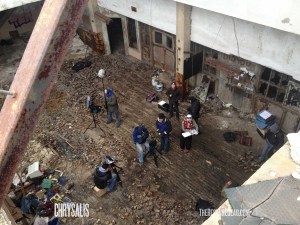
Chrysalis, a 2014 indie horror/sci-fi film tells the story of two survivors of a post-apocalyptic world set 25 years in the future. When the two encounter another survivor, they must choose whether or not they should invite her to join them as they attempt to escape from the zombie-infected city. The film stars Sara Gorsky and Cole Simon, and is the fourth feature film written by Ben Kurstin and directed by John Klein. Kurstin was also the director of photography.
To achieve post-apocalyptic realism, the film was shot in abandoned sections of Gary, Ind. with a few pick up shots in Chicago, Ill. all during January and February of 2013. Kurstin admits that the city of Gary actually play a huge role in writing the script. “Gary has dozens and dozens of abandoned building that are falling apart,” he said. “I had written a couple of scripts over the last several years which would have been much more expensive to make. I was trying to write something that we could shoot for next to nothing. I found Gary and the narrative just started to form around those locations.”
 Gary is one of the many midwestern cities that provide indie filmmakers with the tax-breaks that allow them to be able to obtain shooting permits at a fairly inexpensive cost. With the assistance of these tax-breaks and the abandoned buildings that required very little set dressing, Klein and Kurstin were well on their way to producing their film while staying within a reasonable budget.
Gary is one of the many midwestern cities that provide indie filmmakers with the tax-breaks that allow them to be able to obtain shooting permits at a fairly inexpensive cost. With the assistance of these tax-breaks and the abandoned buildings that required very little set dressing, Klein and Kurstin were well on their way to producing their film while staying within a reasonable budget.
Chrysalis was funded entirely through Kickstarter, and was originally budgeted to be a $10,000 film. Klein and Kurstin did a lot of research to make sure that their project was one of the more successful Kickstarter endeavors. “People who love the zombie genre get so excited about it,” Klein explained. “There was definitely a chance to capitalize on that excitement.”
With a goal of making $1,000 a day, Klein and Kurstin knew that the only way to make this possible was to offer their funders an amazing incentive to invest. “We had to come up with a really good campaign,” said Klein. “One of our prizes at the $200 level was that you got to come on set and be made up as a zombie. That was our most successful prize. We sold out the first 10 in a day or two. [Even as we added more] they would sell out. People liked the idea of having an experience like that.” Ultimately, the project ended up raising $35,000.
 While the locations were perfect for a post-apocalyptic zombie film, they might have been a little too perfect, as many of the building were falling apart while the cast and crew were on set. Klein stated, “The median temperature was 35 degrees. Water would sometimes get into the building and would freeze everything in place, and then when it started to thaw, parts of the ceiling would cave in.” Kurstin added, “Because of the nature of these locations, you worry if they are going to even have insurance. The best thing we did on this film was make sure we had the funds to have all of our insurance and permits taken care of. We were obviously very cognizant of that. It was important for us that we were keeping people safe and secure.”
While the locations were perfect for a post-apocalyptic zombie film, they might have been a little too perfect, as many of the building were falling apart while the cast and crew were on set. Klein stated, “The median temperature was 35 degrees. Water would sometimes get into the building and would freeze everything in place, and then when it started to thaw, parts of the ceiling would cave in.” Kurstin added, “Because of the nature of these locations, you worry if they are going to even have insurance. The best thing we did on this film was make sure we had the funds to have all of our insurance and permits taken care of. We were obviously very cognizant of that. It was important for us that we were keeping people safe and secure.”
Every day before any of the cast or crew walked on set, Klein and Kurstin would go into the locations to make sure the ceilings were intact and that there was no debris that could cause danger to anyone.
With only three primary roles, it was very typical for the Chrysalis filmmakers to shoot anywhere from five-10 pages a day. The weather continued to pose a challenge because most shooting days lasted around 10 hours, even though there are only about nine hours of useable daylight during Indiana winters. Despite this inconvenience Klein and Kurstin made the best of the situation. Klein stated, “We had a lot of really fast-paced days. Ben wasn’t lighting for two hours. He was very smart about placing his camera at the right place during the right time of day, only making use of electricity when we had it. There’s just a mentality in a movie like this that you can’t be a perfectionist.”
 Kurstin echoed those thoughts about the Chrysalis production by stating, “At the end, I had 1,000 new gray hairs. My feet became blocks of ice. I had some pretty bad nerve damage from the shins down, but we just kept doing it every day. It was a rough shoot in every possible way, but it was so much fun.”
Kurstin echoed those thoughts about the Chrysalis production by stating, “At the end, I had 1,000 new gray hairs. My feet became blocks of ice. I had some pretty bad nerve damage from the shins down, but we just kept doing it every day. It was a rough shoot in every possible way, but it was so much fun.”
Chrysalis is now available through therestaredead.com and Video On Demand to rent or for purchase and is domestically distributed through Barnholtz Entertainment and internationally through Artist View Entertainment.





